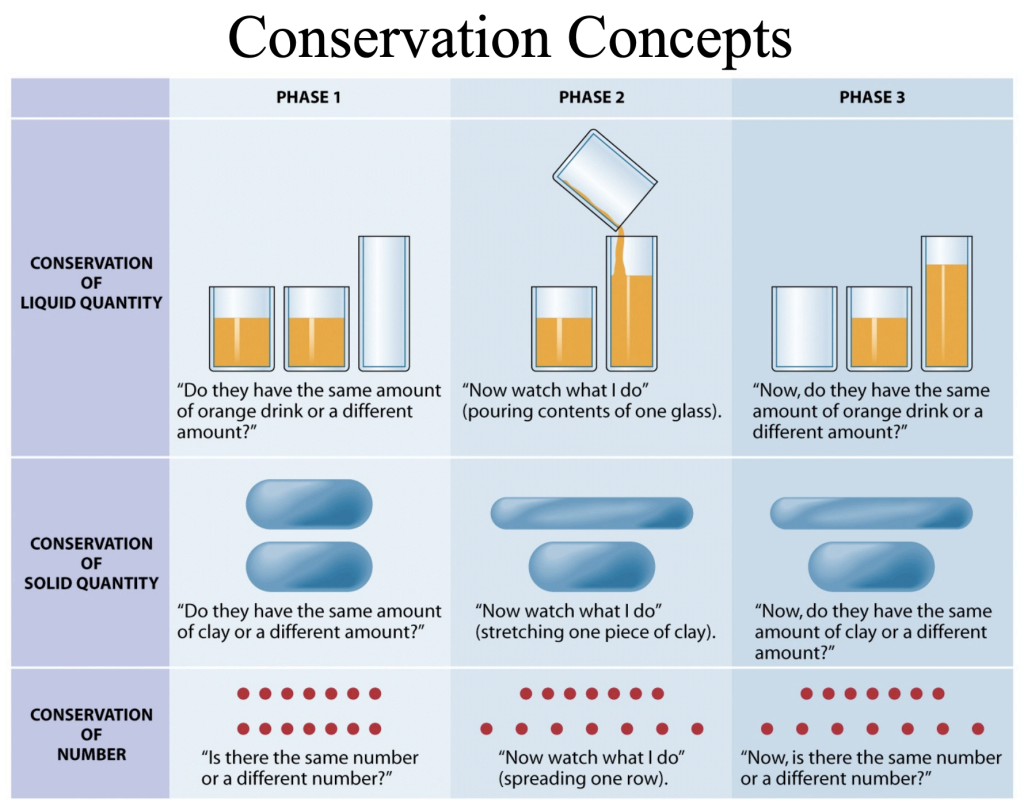Chapter Eight: Early Childhood Development
Cognitive Development in Early Childhood
Learning Objectives
- What cognitive changes occur in early childhood?
- How do young children develop language?
- What are some important features of early childhood education?
Piaget’s Preoperational Stage: Operations are an internalized set of actions. During the preoperational stage, stable concepts are formed. Mental reasoning and magical beliefs emerge. Egocentrism strengthens, then weakens. Thought is still flawed and not well organized.
The symbolic function substage is the first substage of preoperational thought. It occurs between the ages of 2 to 4. The child gains an ability to mentally represent an object not present. Drawings are imaginative.
There are two limitations on preoperational thought. Egocentrism is a child’s inability to distinguish between one’s own perspective and someone else’s. Animism is the belief that inanimate objects have lifelike qualities and are capable of action.
The intuitive thought substage occurs between 4 and 7 years of age. Children begin to use primitive reasoning and seek answers to all sorts of questions. Centration and conservation occur during this stage. Centration is the focusing of attention on one characteristic to the exclusion of all others. Conservation realizes that altering an object’s substance does not change it quantitatively (Berk, 2017; Santrock, 2013; Jensen & Arnett, 2019).

Vygotsky’s Theory of Development
Vygotsky believed that children actively construct their knowledge and understanding. Their ways of thinking develop primarily through social interaction. He believed that all members of a classroom could be both teachers and learners. He theorized that each child has a zone of proximal development at each stage in their learning. The Zone of Proximal Development has two limits: the lower limit is what a child can achieve independently, and the upper limit is what can be achieved with the guidance and assistance of adults or more skilled children. Vygotsky introduced the notion of scaffolding in instruction, which is changing the level of support over the course of a teaching session to fit the child’s current performance level. Guided participation is used to stretch and support children’s understanding of skills.
Language and thought: Children use language to plan, guide, and monitor their behavior. Private speech (self-talk) is an early transition to being more socially communicative. It is used more when tasks are difficult (Berk, 2017; Santrock, 2013; Jensen & Arnett, 2019).
Teaching Strategies Vygotsky Would Agree With
Use a child’s zone of proximal development
Use more skilled peers as teachers
Monitor and encourage private speech
Effectively assess the child’s zone of proximal development
Place instruction in a meaningful context
Transform the classroom to encourage group learning (Berk, 2017; Santrock, 2013; Jensen & Arnett, 2019).
Vygotsky vs. Piaget
Vygotsky is a social constructivist; Piaget is a cognitive constructivist.
In Vygotsky’s theory, no general stages of development are proposed. In Piaget’s theory, there is a strong emphasis on stages of development: sensorimotor, preoperational, concrete operation and formal operational.
Vygotsky believed that language shapes thought; Piaget believed that language has a small role. Thought directs language.
Vygotsky believed that education plays a central role in helping children learn about culture. Piaget believed that education just refined the child’s skills that had already emerged.
Vygotsky believed that a teacher is a facilitator and guide and that it was important to provide many opportunities for children to learn with a teacher and more skilled peers. Piaget also viewed the teacher as the facilitator and guide, someone to provide support for children to explore their world and discover knowledge (Berk, 2017; Santrock, 2013; Jensen & Arnett, 2019).
Literacy in Early Childhood Education
Literacy is the understanding of language. Literacy encompasses reading, writing, listening and speaking. Children develop literacy when they have the opportunity to speak, when they have active language partners, and when they are read to.
Nourishing the Young Child’s Cognitive Development
Caregivers should provide opportunities for young children to develop symbolic thought by encouraging exploration
Being an active language partner
Being sensitive to the child’s level of cognitive functioning: what they can do with and without your help.
Evaluating the quality of the child’s early childhood programs.
Media Attributions
- Conservation Concepts © Eliana Colunga via. University of Colorado, Boulder is licensed under a All Rights Reserved license

